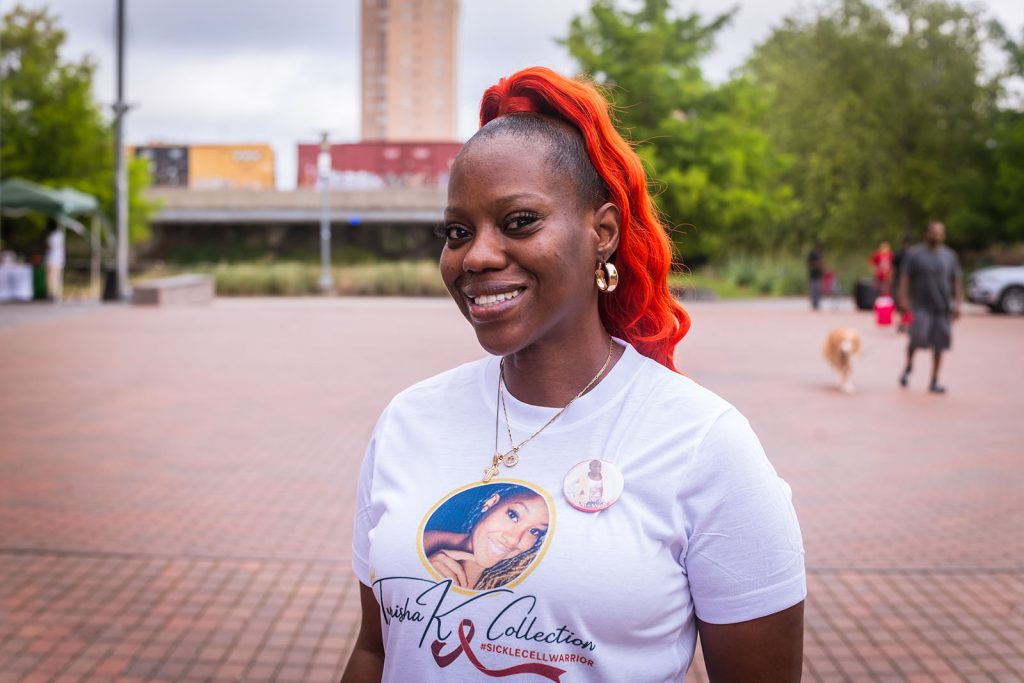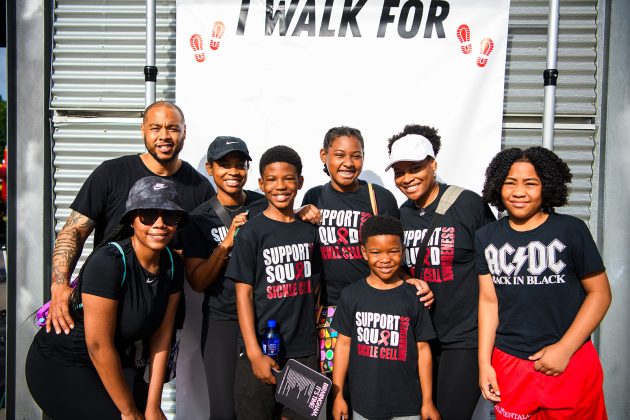
By Javacia Harris Bowser | For the Birmingham Times
Asked how sickle cell disease (SCD) impacts her life, Birmingham’s Alaynna Pruitt said bluntly, “It literally affects everything.”
A sickle cell crisis — a term patients use to describe unbearable pain or other serious complications brought on by the disease — can be unpredictable, Pruitt said.
“I’ll get a crisis somewhat randomly, but it’s usually brought on by overexertion or dehydration,” she said.
Temperature changes, either extreme heat or extreme cold, can also cause problems. For Pruitt, a crisis often manifests itself as intense pain in her legs, arms, or chest.
Still, SCD hasn’t stopped Pruitt from living a full life. She enjoys hiking, Pilates, and yoga. She also likes to travel and recently took a trip to Niagara Falls.
“It just takes proper planning and knowing what hospitals are around in case something happens,” Pruitt said.
Birmingham’s Tynisha Hall, who was diagnosed with SCD at birth, has also had to endure her own sickle cell crises.
“When you start feeling the pain increase, the only option is the [emergency room (ER)] when your home meds aren’t helping. The crisis can be a few days to weeks, even months for some people. But we all carry it differently,” she said.
But the pain hasn’t stopped Hall either.
Today, she works in Birmingham as a program director for a local organization that transports elderly and disabled seniors to their doctor’s appointments and serves as an advocate for SCD patients, or “sickle cell warriors,” as those battling the disease are sometimes called.
Approximately 70,000 to 100,000 Americans have SCD, according to the American Society of Hematology. The Centers for Disease Control and Prevention (CDC) describes SCD as a group of inherited red blood cell disorders. Pain develops when sickle-shaped red blood cells block blood flow through tiny blood vessels to the chest, abdomen, and joints.
June 19 is World Sickle Cell Day, but for people like Pruitt and Hall SCD is top of mind most, if not all, days of the year. The disease hasn’t kept Pruitt and Hall from thriving, though — thanks, in part, to the support they get from the Central Alabama Chapter of the Sickle Cell Disease Association of America.
After putting several programs on pause due to staff changes, the organization is now rebuilding and working to offer several new opportunities, including urban gardening and arts therapy.
“I would like to see our organization become more conscious of the holistic care of a sickle cell client,” said Sophia Leverson, executive director of the Sickle Cell Disease Association of America–Central Alabama, which hosted its 27th Annual Magic City Sickle Cell Walk on June 14, 2025, at Railroad Park in downtown Birmingham.
The Central Alabama Chapter of the Sickle Cell Disease Association of America began in 1976 as a group of concerned citizens who wanted to raise awareness about SCD, make the sickle cell test a standard physician-offered exam, and ensure that those living with SCD were getting the care they needed.
The project would eventually grow into the Sickle Cell Disease Association of America–Central Alabama and serve more than a dozen counties, including Jefferson, Shelby, St. Clair, and Talladega. The organization has provided a wealth of services, such as counseling, mentor groups, transportation and financial assistance, and summer camps for kids living with SCD.
Leverson, who took the helm of the organization in November 2023, has worked diligently to get the Central Alabama chapter back on track after much of its work had to be put on hold after its staff dwindled to zero. Today, the organization has three full-time staff members and two contract workers. Over the course of a year, about 130 volunteers help with various events.
Through the years, the Sickle Cell Disease Association of America–Central Alabama Chapter has made a difference in many lives—and two local sickle cell warriors have shared their stories with The Birmingham Times.

Alaynna Pruitt: Empowering Others
Like most people living with SCD, Pruitt was diagnosed before her first birthday. As a child, Pruitt, now 29, lived in Birmingham’s Ensley neighborhood, just minutes from the headquarters for the Sickle Cell Disease Association of America–Central Alabama. Even when her family relocated to the Roebuck neighborhood, she could still count on the organization to help her with transportation to doctor’s appointments when needed.
Though she’s in mild to moderate pain most days, she experiences a sickle cell crisis only about four to six times a year and usually is hospitalized only once a year, Pruitt said.
When a crisis hits, Pruitt first tries to manage the pain at home with her prescribed medication and rest. She will also drink plenty of water and apply heat to the affected area.
“More often than not, I can manage at home this way and sometimes can continue to work or do other activities,” she said.
But sometimes a sickle cell crisis can mean a trip to the ER and even hospitalization.
“When it’s really bad, it truly is some of the worst pain I think I’ll ever experience,” Pruitt said. “It requires a great deal of mental toughness to get through and know you’ll eventually be fine, but you do feel so helpless in the moment.”
These tough moments don’t keep Pruitt down for long, though. She keeps herself as healthy as possible with regular exercise and nutritious food. Pruitt has a rewarding job, too, working as a clinical research cook at the University of Alabama at Birmingham (UAB).
“We study how diet affects different diseases,” she explained, adding that it was her interest in nutrition that made her eager to help with the new urban gardening program at the Sickle Cell Disease Association of America–Central Alabama.
“This was actually my first time gardening,” Pruitt said. “[Sophia Leverson] has been teaching me some things as we go along. As I continue to get more involved in the food industry, I’ve had a growing interest in the process of growing food, so I was excited to have the opportunity to help with this one.”
Pruitt, who recently led a cooking demonstration at the center, said, “I hope other warriors know that adopting a healthier lifestyle is not out of reach. I want them to be empowered to produce and cook foods that are better for our bodies.”

Tynisha Hall: Being a Voice
“I’ve lost 18 friends to sickle cell,” Hall said solemnly.
People with SCD can die from various complications, including infections, acute chest syndrome, strokes, and organ failure.
But Hall, who was diagnosed with SCD at birth, turned her pain into purpose. In 2018, she launched a clothing line of SCD awareness apparel called the Tynisha K. Collection. She also hosts a podcast—Tynisha K & Co.—that’s all about how she and her friends rely on faith to make it through everyday struggles.
“My faith is very big to me. That’s what has pushed me through a lot of things,” said Hall, who also volunteers with several sickle cell organizations, including the Sickle Cell Disease Association of America–Central Alabama.
Hall, 36, has fond memories of going to the organization’s headquarters as a kid for holiday parties and other events. And what she loved most was attending the camp for kids living with SCD that the organization hosted each summer in Sylacauga, Alabama.
“We had a great time at camp,” Hall said. “The camp also instilled in us to be a voice for yourself, to say something when you don’t feel good, to speak up.”
When she was a teen, her family relocated to Delaware, and after high school she attended Delaware State University, a Historically Black College and University (HBCU) in Dover, Delaware.
“I got really sick on campus,” Hall recalled.
When she made it to the hospital, she found that none of the health care professionals there had experience with SCD: “I had to basically teach the doctors what I knew,” she said.
This experience inspired Hall to do all she could to spread awareness of SCD on campus and beyond. She started volunteering at the local hospital and hosting programs on campus so students could get tested for sickle cell trait, which is an inherited blood disorder that affects approximately 8 percent of African Americans.
“About 60 to 80 students ended up having sickle cell trait and didn’t know it,” Hall recalled. “Where I was located [in Delaware], nobody was talking about sickle cell, so that put the fire under me.”
In 2014, after earning a degree in mass communications with a concentration in broadcast journalism, Hall moved to Atlanta, Georgia, for a job. During her 90-day probationary period she had a sickle cell crisis and couldn’t work, which led to her losing the job.
Hall shared that she’s in pain most days of the week. She manages her pain with medication, hot showers, and heating pads, but during a sickle cell crisis none of that works.
“A sickle cell crisis can happen at any time. When you start feeling the pain increase, the only option is the ER when your home meds aren’t helping. The crisis can be a few days to weeks, even months for some people. But we all carry it differently,” said Hall, adding that she typically has pain in her legs, arms, and back.
But the pain hasn’t stopped her. In fact, it has fueled her passion for serving as an advocate for her fellow sickle cell warriors.
“When I find out a warrior is in the hospital, if they’re comfortable with it, I reach out to them,” said Hall. “I take a little goodie bag and a card and some flowers, balloons, just something to make them feel better, and I pray with them.”
Additionally, she volunteers with a Georgia-based camp for kids with SCD, an effort she describes as her “biggest joy.”
Hall also devotes time to the Sickle Cell Disease Association of America–Central Alabama. She’s helped Leverson with several events, including the recent Magic City Sickle Cell Walk, a balloon release for sickle cell warriors who have passed away, and an ice cream social fundraiser.
“You Can’t See the Pain”
Asked what they wished more people understood about SCD, both Hall and Pruitt stressed that most sickle cell warriors don’t look like what they’ve been through.
“Sometimes we look absolutely fine,” Hall said. “You can’t see the pain, so you look at us, and most of us are beautiful, we dress nice, we look good. But that doesn’t overshadow the pain.”
Pruitt added that SCD doesn’t affect all people in the same ways. There are several different types of SCD, and symptoms can range from mild to life-threatening.
“It’s different for everyone and doesn’t look one way,” Pruitt said. And looks can’t always tell you how a sickle cell patient feels.
“I’ve been at whole events in pain, and no one would’ve known if I didn’t say anything,” Pruitt said. “We have high pain tolerance and high mental resilience. We can handle a lot.”
Learn more about the Sickle Cell Disease Association of America–Central Alabama at sicklecellbham.org.
What is Sickle Cell Disease?
Sickle Cell Disease (SCD) refers to a group of inherited red blood cell disorders, as explained by the Centers for Disease Control and Prevention (CDC). While healthy red blood cells are round and move through small blood vessels to carry oxygen to all parts of the body, with SCD the red blood cells become hard and sticky and are shaped like a crescent or sickle. The sickle cells die early, which causes a constant shortage of red blood cells. Also, when they travel through small blood vessels, they get stuck and obstruct the blood flow. This can cause pain and other serious complications, such as infections, acute chest syndrome, and strokes.
SCD is diagnosed with a simple blood test and is most often identified at birth or within the first year of life. Symptoms of the disease can start as early as 4 months.
Approximately 70,000 to 100,000 Americans have SCD, according to the American Society of Hematology.
“There are a lot of misconceptions about SCD, and one of the things that I want to highlight is that a lot of people think that only individuals who are Black or African American [are affected by the disorder]—and that actually is not the case,” said Sophia Leverson, executive director of the Sickle Cell Disease Association of America–Central Alabama.
SCD is more common not only in people of African descent (including African Americans) but also in Hispanic Americans from Central and South America, as well as people of Middle Eastern, Asian, India, and Mediterranean descent.
“And there are more Caucasian people being diagnosed with sickle cell,” Leverson said. “In fact, Italians also have a predisposition to it.”
Sickle cell trait is an inherited blood disorder that affects approximately 8 percent of African Americans. Unlike SCD, in which patients have two genes that cause the production of abnormal hemoglobin, individuals with sickle cell trait carry only one defective gene and typically live normal lives without health problems related to SCD. However, extreme conditions, such as severe dehydration and high-intensity physical activity, can lead to serious health issues in individuals with sickle cell trait—although this is rare.











